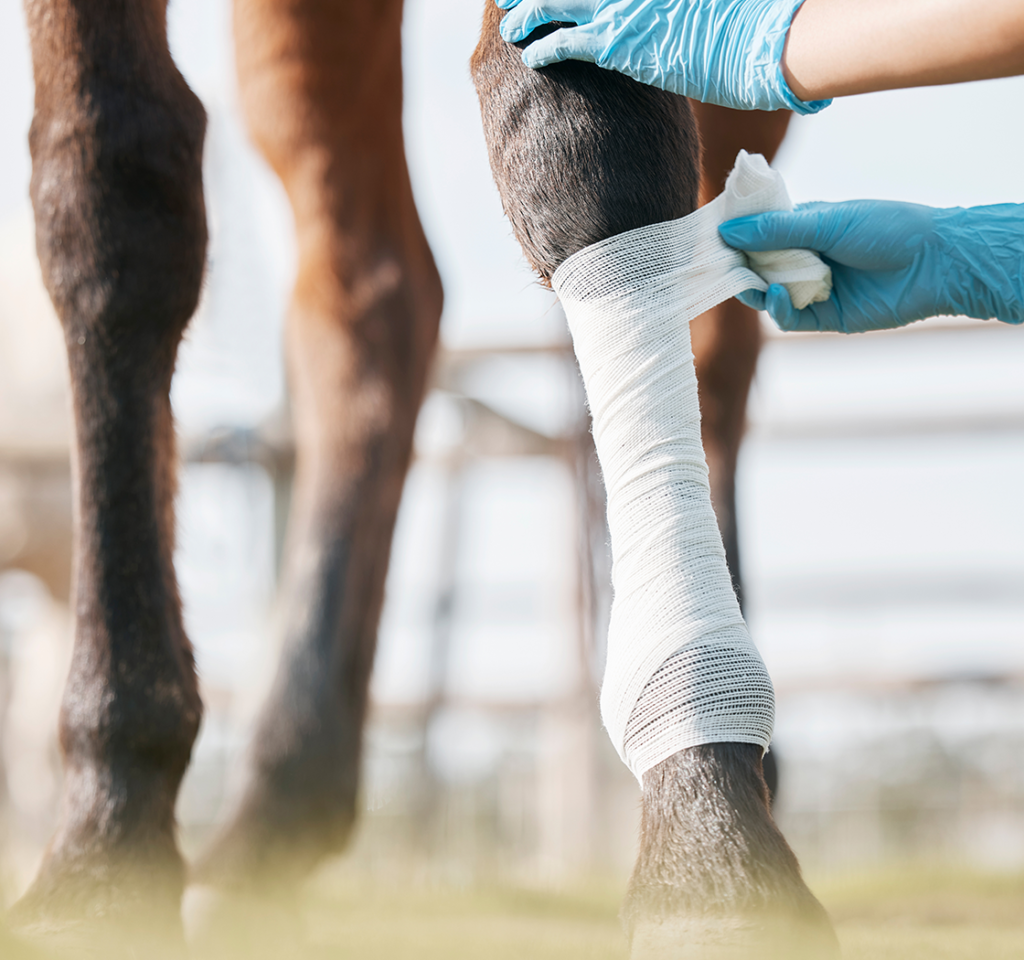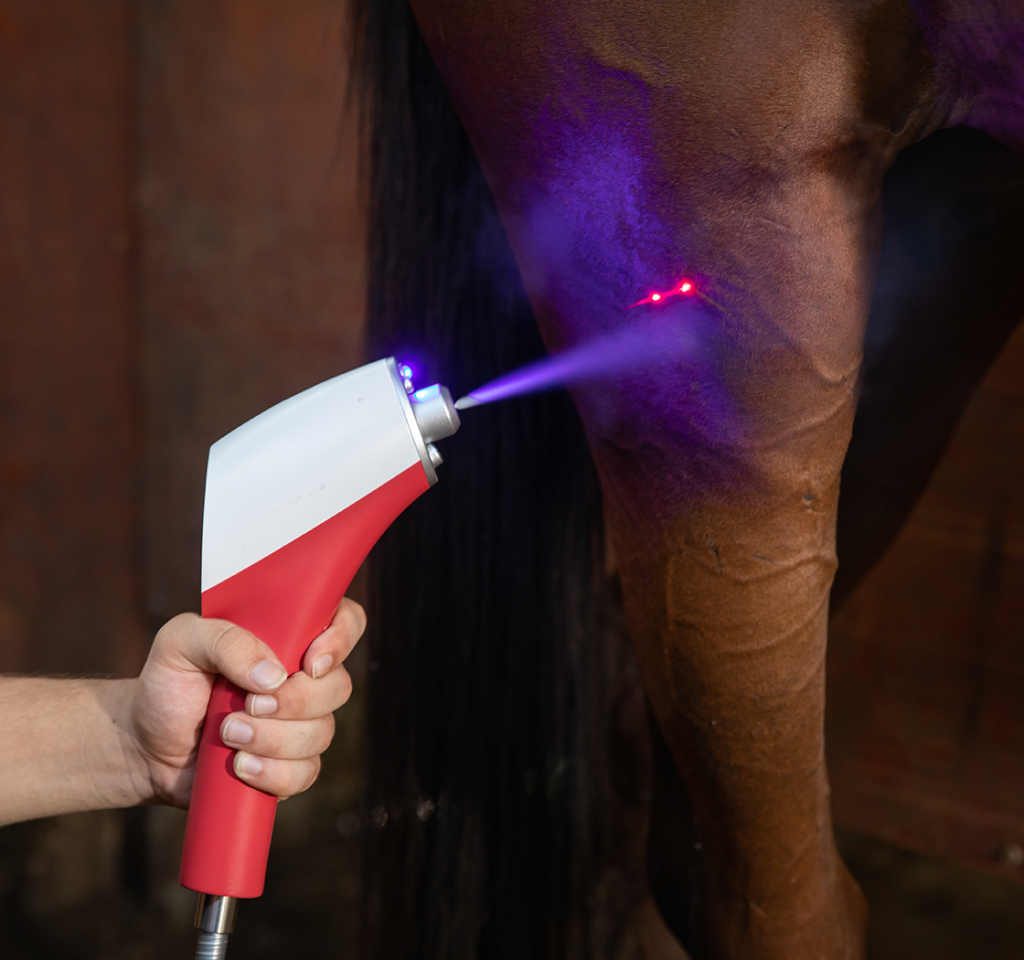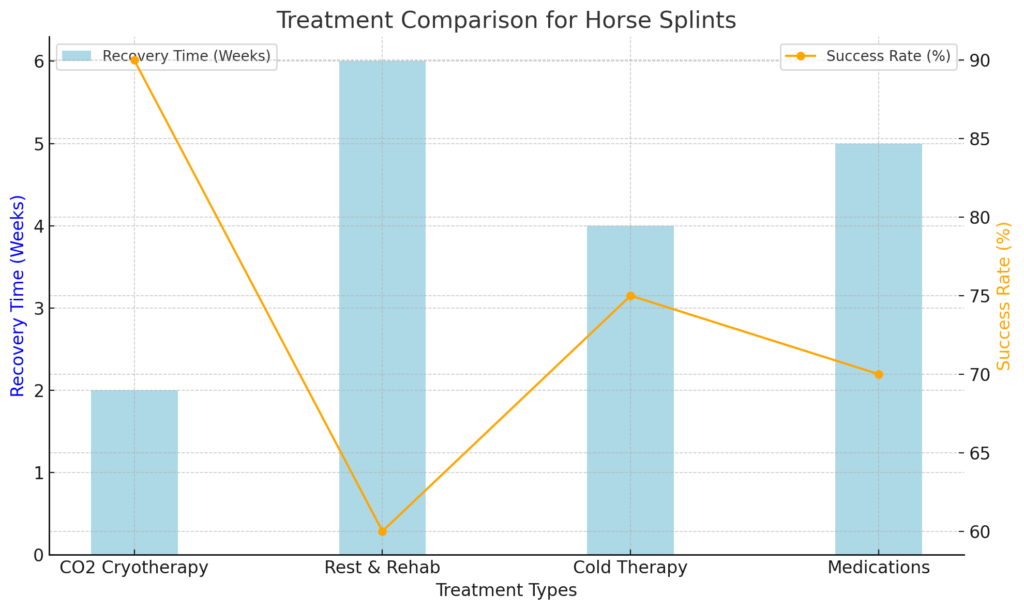Horse splints are a common injury that can significantly impact an equine athlete’s performance. They usually occur as inflammation or bone growth on the splint bone, located on the front of the lower leg. While splints are common in high-impact sports like racing and show jumping, they can also affect horses in other disciplines. Traditionally, treatment options included rest, rehabilitation, cold therapy, and medications. However, recent advancements like CO2 Cryotherapy offer promising alternatives for faster recovery with minimal side effects. In this blog, we’ll dive into horse splints, traditional treatments, and how CO2 Cryotherapy can speed up recovery.
A Common Injury in Equestrian Athletes
What Are Horse Splints?
Splints are bony protrusions that form along the front of a horse’s lower legs, specifically on the splint bones. The splint bone itself is a vestigial structure that plays a supportive role in stabilizing the horse’s limbs. However, when the splint bone experiences stress, trauma, or excessive strain, it can lead to inflammation, bone growth, and sometimes fractures. This bony enlargement is the splint, which can cause pain, discomfort, and functional impairment. These injuries can occur due to excessive training, poor conformation, or traumatic injury. In some cases, the splints are small and may not cause much discomfort or lameness. However, in more severe instances, they can lead to significant pain and swelling, potentially affecting the horse’s performance and overall soundness.
Symptoms of Horse Splints
The symptoms of splints are often visible and can be identified by changes in the leg’s appearance. Here are the common symptoms to watch for:
- Swelling: This is the most visible symptom of splints. It typically appears on the inside or outside of the lower leg, just below the knee. The swelling may be firm or soft depending on the severity of the injury.
- Lameness: Horses with splints may exhibit signs of lameness, such as limping or reluctance to move. They may favor the affected leg, shifting their weight to the sound leg.
- Heat and Tenderness: The area around the splint may feel warm to the touch, indicating inflammation. The horse may show signs of tenderness when the affected area is palpated.
- Pain on Pressure: Affected horses often react with discomfort when pressure is applied to the splint area.
- Development of a Bony Lump: In chronic or severe cases, the splint bone may form a hard lump, which can be felt as a raised area along the leg.

Risk Factors for Splints in Horses
Several factors contribute to the development of splints in horses, some of which are beyond the owner’s control, while others can be managed with proper care:
- Age: Younger horses, particularly those between one and three years old, are more likely to develop splints due to the immaturity of their bones and ligaments. Their legs are still growing and developing, making them more susceptible to injury during training or high-impact activity.
- Excessive Training: Horses that undergo intensive training, particularly those engaged in speed-related sports like racing, eventing, or show jumping, are at a higher risk of developing splints. Repetitive strain on the legs increases the chances of trauma to the splint bones.
- Conformation: Horses with conformation issues, such as straight or improperly aligned legs, may be at a greater risk of developing splints. Poor conformation places uneven stress on the limbs, leading to an increased likelihood of injury.
- Trauma and Overuse: Sudden, high-impact trauma or repetitive use of the legs can lead to injuries in the splint bone, particularly if the horse is involved in high-stress activities like jumping or racing.
Traditional Treatments for Horse Splints
Rest and Rehabilitation
Rest is often the first line of treatment for horses with splints. The goal is to give the injured area time to heal and reduce the strain on the affected limb. During this period, the horse may be confined to a stall or a small paddock to restrict movement and prevent further stress on the splint bone. While rest is essential for recovery, it must be managed carefully, as excessive inactivity can lead to stiffness or muscle atrophy. Once the acute inflammation subsides, controlled rehabilitation can be introduced. Rehabilitation may include gentle walking, low-impact exercises, or physical therapy to restore strength and mobility in the leg. This gradual reintroduction of exercise helps the horse regain its range of motion and avoid stiffness.
Cold Therapy and Ice Treatments
Cold therapy is a staple in the treatment of horse splints. The primary purpose of ice or cold packs is to reduce inflammation and numb the pain in the affected area. Cold therapy constricts blood vessels, limiting the flow of inflammatory fluids to the injured area. This helps reduce swelling and discomfort. However, while ice therapy is effective in the acute phase of injury, it has limitations. Ice therapy only provides short-term relief and doesn’t directly promote healing. Prolonged use can also reduce circulation, potentially delaying recovery if not properly managed.
Medications and Joint Injections
In more severe cases, pain management and inflammation control may require medications such as nonsteroidal anti-inflammatory drugs (NSAIDs) or corticosteroids. These medications can help reduce swelling and alleviate pain, making the horse more comfortable. In addition, joint injections or local corticosteroid injections may be used to target the inflamed area more directly. However, medications and injections are not without risks. Long-term use of anti-inflammatory drugs can have side effects, including gastrointestinal issues or kidney problems. Joint injections carry a risk of infection or complications, and while they can provide relief, they don’t address the underlying cause of the splint.
CO2 Cryotherapy for Horse Splints
How CO2 Cryotherapy Works
CO2 Cryotherapy is an innovative treatment that uses carbon dioxide (CO2) in a gaseous or solid form to rapidly cool the tissue. The treatment works by applying CO2 to the injured area of the horse’s leg, which causes the blood vessels to constrict, reducing swelling and inflammation. As the CO2 evaporates or dissipates, blood vessels dilate, increasing blood flow to the area. This enhanced circulation delivers oxygen and nutrients to the affected tissue, promoting faster healing. The cooling effect of CO2 Cryotherapy also helps to numb the area, providing immediate pain relief. This combination of reduced inflammation, enhanced blood flow, and pain management makes CO2 Cryotherapy an effective tool for treating horse splints.

Benefits of CO2 Cryotherapy for Horse Splints
CO2 Cryotherapy offers several key benefits for horses suffering from splints:
- Faster Recovery: CO2 Cryotherapy accelerates the body’s natural healing processes by promoting cellular repair and regeneration. This allows horses to recover more quickly compared to traditional treatments.
- Non-Invasive and Safe: Unlike injections or surgery, CO2 Cryotherapy is non-invasive and carries minimal risks. Horses typically experience little discomfort during the treatment, and there are no known long-term side effects.
- Reduced Inflammation and Pain: Cryotherapy provides immediate relief by reducing inflammation and swelling, while also helping to manage pain. This results in improved comfort and a faster return to work for the horse.
- Improved Circulation: The cooling effect of CO2 Cryotherapy promotes better circulation in the affected area, delivering oxygen and nutrients to the tissue, which accelerates the healing process.
Procedure and Application in Horses
The procedure for CO2 Cryotherapy is relatively simple and non-invasive. A cryotherapy machine is used to direct a stream of CO2 onto the injured area of the horse’s leg. The process typically lasts around 10-15 seconds, and the horse remains relaxed throughout the treatment. Multiple sessions are often required to achieve optimal results. A typical course of treatment may involve 5-10 sessions, depending on the severity of the splint and the horse’s response to the therapy. CO2 Cryotherapy can be used in conjunction with other rehabilitation methods, such as controlled exercise and physiotherapy, for a comprehensive recovery plan.
Innovative Advantages of CO2 Cryotherapy for Horse Splints
CO2 Cryotherapy is revolutionizing the way equine professionals approach injury recovery. By using carbon dioxide, a naturally occurring compound, this advanced form of cryotherapy offers multiple benefits over traditional cold therapy and other treatments for horse splints.
Faster Healing at the Cellular Level
One of the key benefits of CO2 Cryotherapy is its ability to accelerate healing at the cellular level. The cold-induced vasoconstriction (narrowing of blood vessels) followed by rapid vasodilation (widening of blood vessels) stimulates blood flow to the affected tissue, reducing inflammation and enhancing the delivery of oxygen and nutrients for faster cellular repair. Cryotherapy also promotes the production of anti-inflammatory proteins while inhibiting substances that contribute to inflammation. This targeted approach speeds up healing, helping damaged cells regenerate quicker than with rest or traditional treatments. CO2 Cryotherapy can reduce scar tissue formation, allowing muscles and tissues to heal more naturally without the stiffness often caused by other treatments. Faster recovery enables horses to return to training or competition sooner, a crucial factor for equestrian athletes.
Non-Invasive and Safe for Horses
CO2 Cryotherapy is a non-invasive treatment with no cuts or needles, reducing the risk of complications like infections. Horses typically tolerate the procedure well, with minimal discomfort. It’s safe for horses of all ages and fitness levels, including those with pre-existing conditions. Since it targets only the injured area, surrounding tissues remain unaffected, further minimizing risk. Additionally, CO2 Cryotherapy has no known long-term side effects, making it a safe and repeatable option for both acute injuries and chronic conditions.
Adaptable to Horses of All Activity Levels
CO2 Cryotherapy is adaptable for both high-performance competitors and casual riding horses. For competitive horses in disciplines like racing, eventing, and show jumping, it speeds up recovery, minimizing downtime between training or competitions. For recreational or older horses with joint issues from everyday activity, it offers a gentle, effective way to alleviate pain and promote healing. This makes CO2 Cryotherapy suitable for horses at any age or activity level. It can also serve as a preventive measure for horses at higher risk of injury, enhancing circulation and supporting tissue repair to reduce the likelihood of issues like splints. Whether for young athletes or aging companions, CO2 Cryotherapy helps horses recover faster and maintain optimal health.
CO2 Cryotherapy in Action
CO2 Cryotherapy has already made a significant impact on the equine industry, with numerous reports from both horse owners and veterinarians highlighting its effectiveness. The real-world results of CO2 Cryotherapy underscore its promise as a treatment for horse splints.

Horse Owners Share Results
Many horse owners have seen noticeable improvements in their horses’ mobility and recovery times after using CO2 Cryotherapy for splints. One common feedback from owners is that their horses experienced a reduction in swelling and inflammation after just a few sessions. As the treatment progresses, owners often report that their horses exhibit less discomfort and a greater willingness to engage in normal activities, including walking, trotting, and even jumping. Owners have also noted a reduction in the need for medications and other more invasive treatments, as CO2 Cryotherapy provides a non-pharmaceutical solution for managing pain and inflammation. Horses that were once limited in their activity due to splints have returned to their regular training schedules or competitions much sooner than expected.
Veterinary Endorsements: Experts Weigh In
Veterinarians are enthusiastic about CO2 Cryotherapy and often recommend it as part of a comprehensive treatment plan for horses with splints. They highlight its effectiveness in reducing acute inflammation and promoting faster healing compared to traditional cold therapies. Experts also appreciate that it can complement other treatments, such as rest, rehabilitation, and controlled exercise, creating a well-rounded recovery approach. Veterinarians report that CO2 Cryotherapy helps manage pain and swelling without relying on long-term medications like NSAIDs, which can have side effects. Its non-invasive nature reduces the risk of complications, and there’s no recovery time needed after treatment. Some veterinarians have even incorporated CO2 Cryotherapy into their practices for various conditions, including soft tissue injuries, tendonitis, and arthritis.
The Future of CO2 Cryotherapy in Equine Care
As the use of CO2 Cryotherapy continues to grow, its role in equine care is expected to expand. This innovative treatment is poised to become an integral part of many equine rehabilitation and injury prevention programs, with broader applications on the horizon.
Cryotherapy as Part of a Comprehensive Recovery Program
CO2 Cryotherapy is already making its mark in comprehensive recovery programs, and it is expected to play an even larger role in the future. Veterinary professionals are increasingly recognizing the benefits of combining cryotherapy with other therapies such as massage, hydrotherapy, and physical rehabilitation. Together, these methods can help ensure that horses recover more effectively and return to work sooner. Future research and development may even lead to protocols that combine cryotherapy with stem cell therapy or platelet-rich plasma (PRP) injections, two treatments that are already gaining popularity for equine injury recovery.
Expanding the Applications of CO2 Cryotherapy
The applications of CO2 Cryotherapy go beyond splints, extending to muscle strains, tendonitis, and arthritis. Researchers are exploring its potential in injury prevention, especially for high-performance horses. As cryotherapy technology evolves, it may also be adapted for wound healing and post-surgery rehabilitation, offering more benefits for horses in need of care.
The Role of Technology in Shaping Equine Healthcare
The role of technology in equine healthcare will continue to evolve, and CO2 Cryotherapy is just one example of how cutting-edge advancements are transforming the industry. With ongoing research, new machines are being developed that allow for even more precise targeting of affected areas, further improving the effectiveness of the treatment. As the understanding of cryotherapy grows, new protocols will emerge, leading to faster, safer, and more effective treatments for a wider range of injuries. Technology will also make it easier to administer cryotherapy treatments, allowing more equine professionals and facilities to adopt this innovative treatment.
FAQs
Q1. What makes CO2 cryotherapy different from regular ice therapy?
Unlike traditional ice therapy, which uses cold to slow down blood flow and reduce inflammation, CO2 Cryotherapy uses carbon dioxide to create a more controlled, rapid cooling effect that promotes better blood flow and accelerates healing at the cellular level. It also has a more profound and lasting effect on reducing inflammation and promoting tissue repair.
Q2. How soon after treatment can my horse return to training?
After CO2 Cryotherapy, horses can typically return to light training within a few days, though this depends on the severity of the injury. Your veterinarian can provide a customized recovery plan, with rest periods and light activities designed to ensure proper healing.
Q3. Can CO2 cryotherapy help prevent splints from recurring?
While CO2 Cryotherapy can’t entirely eliminate the risk of splints recurring, it helps reduce inflammation, enhance tissue healing, and improve circulation, all of which can lower the likelihood of future splints and other injuries.
Q4. Is CO2 cryotherapy safe for all horses, regardless of age or fitness level?
Yes, CO2 Cryotherapy is safe for horses of all ages and fitness levels. It is non-invasive and has no known long-term side effects, making it suitable for young, athletic horses as well as older horses with pre-existing conditions.
Q5. How many sessions will my horse need to see results?
Typically, 5-10 sessions are required for significant improvement. The number of sessions depends on the severity of the injury and the horse’s response to treatment.
Q6. Can CO2 cryotherapy treat other injuries besides splints?
Yes, CO2 Cryotherapy is effective for treating a variety of injuries, including tendonitis, muscle strains, arthritis, and soft tissue damage.
References
The Horse – Diagnosing and Treating Splints
ResearchGate – Review of Basic Trends in Cryotherapy Applications for Horse Injuries



